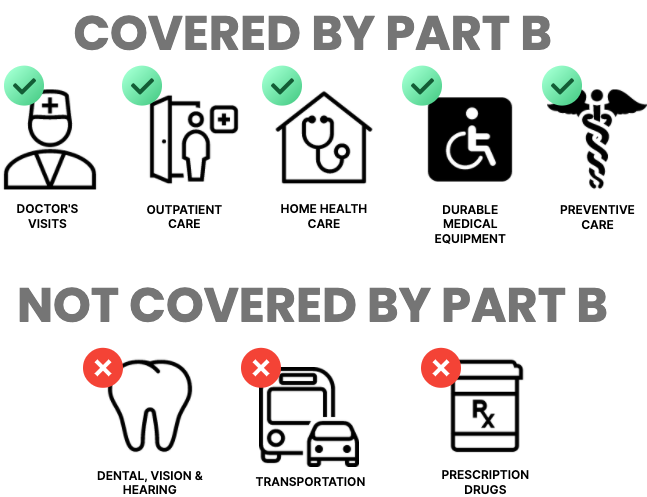Medicare
Medicare is a federal health insurance program in the United States that primarily provides coverage for people aged 65 and older, as well as certain younger individuals with disabilities. It’s administered by the Centers for Medicare & Medicaid Services (CMS) and is designed to help cover various healthcare costs.
Here are the basics of Medicare:
Medicare is divided into several parts – each covering specific healthcare services.
Part A – Hospital Insurance
Part A covers inpatient hospital care, skilled nursing facility care, hospice care, and some home health care services. Most people do not have to pay a premium for Part A if they or their spouse paid Medicare taxes while working.
Part B – Medical Insurance
Part B covers outpatient medical services, such as doctor’s visits, preventive care, laboratory tests, and durable medical equipment. It requires a monthly premium, the cost of which may vary based on your income.
Did You Know?
In addition to the Annual Enrollment Period (AEP) from October 15 to December 7, there is also an Open Enrollment Period (OEP) for Medicare Advantage beneficiaries from January 1 to March 31. If you did not make a change to your Medicare Advantage health coverage during AEP, you have a one-time opportunity to change plans, or leave Medicare Advantage and go back to Original Medicare with a stand alone Part D plan.

Part C – Medicare Advantage
Also known as Medicare Advantage plans, these are offered by private insurance companies approved by Medicare. They provide all the benefits of Parts A and B and often include prescription drug coverage (Part D) and additional benefits like dental and vision. Premiums and coverage can vary.
Part D – Prescription Drug Coverage
Part D provides coverage for prescription drugs. You can enroll in a standalone Part D plan alongside Original Medicare (Parts A and B) or get it as part of a Medicare Advantage plan.
When was the last time you researched your medications across all the plans? We can help! We provide a free service to do just that! Click here and fill out the drug review form and we will research your options – who doesn’t like to save money!
Who is Eligible for Medicare?
Generally, one needs to be:
-
- Age 65 or older
- US Citizen or legal resident for at least 5 continuous years
- Eligible for Social Security or Rail Road Retirement benefits
- Some younger individuals with certain disabilities or end-stage renal disease (ESRD) may also qualify.
What does it cost?
While Part A is usually premium-free for most people, there are costs associated with other parts of Medicare, including Part B premiums, deductibles, copayments, and coinsurance. Part C and Part D plans have their own premium structures and cost-sharing requirements.
Coverage Gaps
Medicare doesn’t cover all healthcare expenses. You may still be responsible for certain out-of-pocket costs, and there are coverage gaps. Some people choose to purchase supplemental insurance known as Medigap policies to help fill these gaps.
Choosing a plan
When you become eligible for Medicare, you have choices to make about your coverage. You can stick with Original Medicare (Parts A and B) and add Part D and Medigap plans if desired, or you can choose a Medicare Advantage plan. It’s essential to compare plans based on your healthcare needs, location, and budget.
Annual Enrollment Period (AEP)
There is an annual enrollment period during which you can make changes to your Medicare coverage. This typically occurs from October 15 to December 7 each year.
Remember that Medicare is a complex program with various options and rules, and it’s crucial to understand your specific needs and circumstances when choosing your coverage. It’s often recommended to seek guidance from a trusted source, such as one of our licensed agents or Medicare.gov, to make informed decisions about your healthcare coverage.

Frequently Asked Questions
Am I eligible for Medicare?
You are typically eligible for Medicare if you are aged 65 or older and either a U.S. citizen or a legal resident who has lived in the U.S. for at least five continuous years. Some younger individuals with certain disabilities or end-stage renal disease (ESRD) may also qualify.
What are the different parts of Medicare
Medicare is divided into four parts: Part A (Hospital Insurance), Part B (Medical Insurance), Part C (Medicare Advantage), and Part D (Prescription Drug Coverage). Medicare Supplements or Medigap are sometimes referred to as Part E, although this is not common.
Do I have to enroll in Medicare?
If you’re receiving Social Security or Railroad Retirement benefits when you turn 65, you are usually automatically enrolled in Medicare Part A and may have the option to enroll in Part B. If you’re not automatically enrolled, you can apply for Medicare during specific enrollment periods. Failure to enroll when you are first eligible COULD result in penalties which are permanent. Consult with one of our agents for personalized advice on your situation.
What does Part A cover?
Part A covers inpatient hospital care, skilled nursing facility care, hospice care, and some home health care services.
What does Part B cover?
Part B covers outpatient medical services, including doctor’s visits, preventive care, laboratory tests, and durable medical equipmen
What is Medicare Advantage (Part C)?
Medicare Advantage plans are offered by private insurance companies approved by Medicare. They provide all the benefits of Parts A and B and often include prescription drug coverage and additional benefits like dental and vision.
What is Medicare Part D?
Part D provides coverage for prescription drugs. You can enroll in a standalone Part D plan alongside Original Medicare or get it as part of a Medicare Advantage plan.
What is Medigap (Medicare Supplement Insurance)?
Medigap policies are private insurance plans that help cover the out-of-pocket costs associated with Original Medicare, such as deductibles, copayments, and coinsurance.
When can I make changes to my Medicare coverage?
You can make changes to your Medicare coverage during the Annual Enrollment Period (AEP), which typically occurs from October 15 to December 7 each year. There are also Special Enrollment Periods (SEPs) for specific circumstances.
How much does Medicare cost?
Costs for Medicare vary depending on the specific parts and coverage options you choose. Part A is usually premium-free for most people, but you’ll pay premiums for Part B and possibly Part D. There are also deductibles, copayments, and coinsurance.
Can I have both Medicare & other insurance, like employer-based coverage?
Yes, many people have both Medicare and other insurance, such as employer-sponsored coverage or Medicaid. Coordination of benefits rules will determine which insurance pays first.
How do I apply for Medicare or get more information?
You can apply for Medicare or get more information by visiting the official Medicare website (Medicare.gov) or contacting the Social Security Administration.
